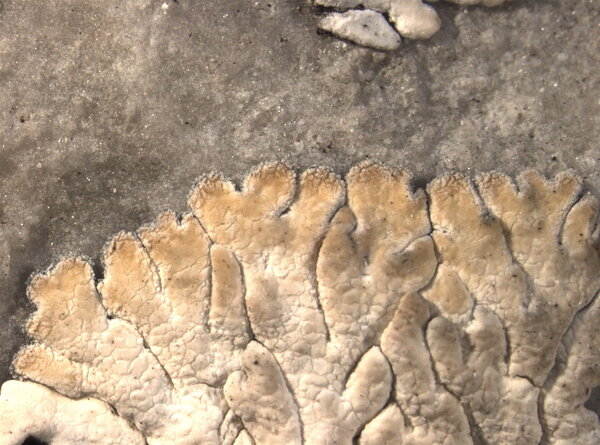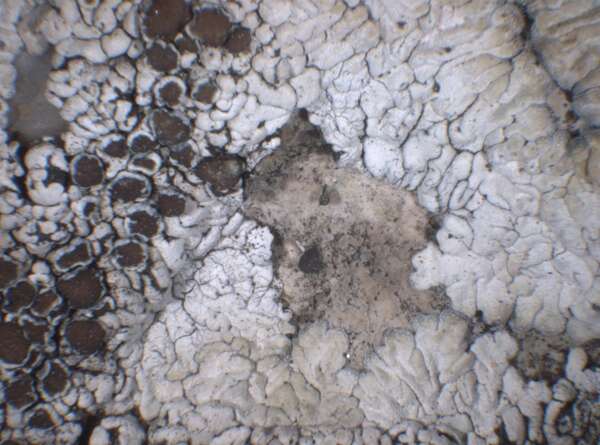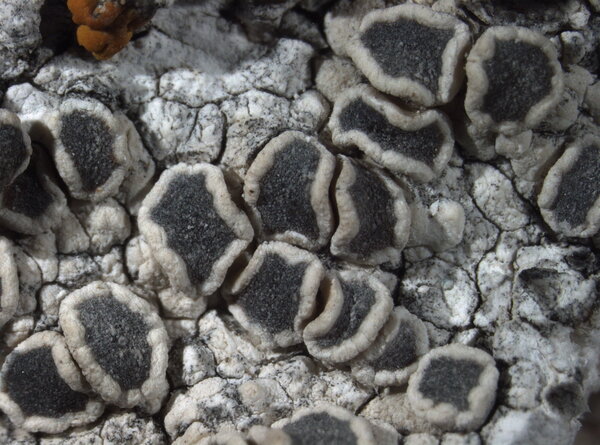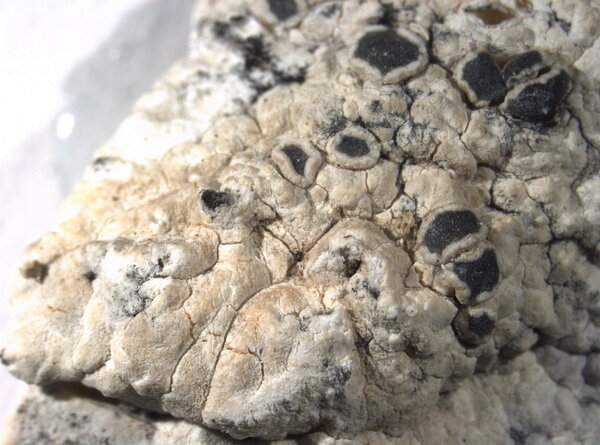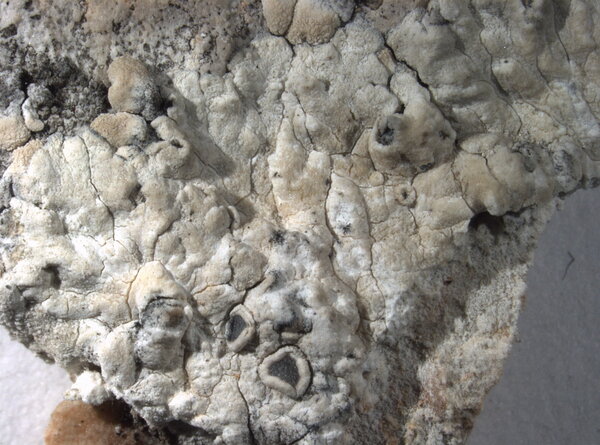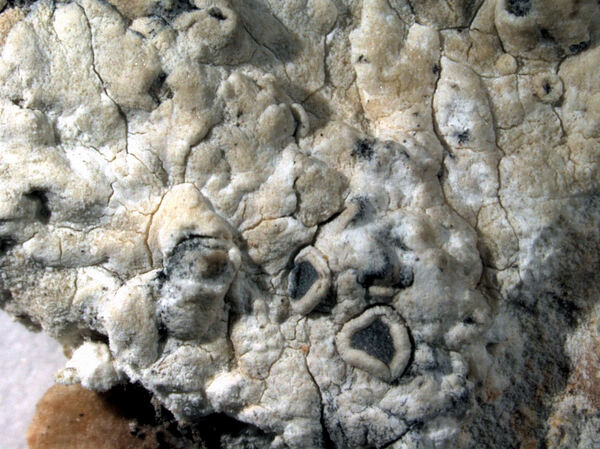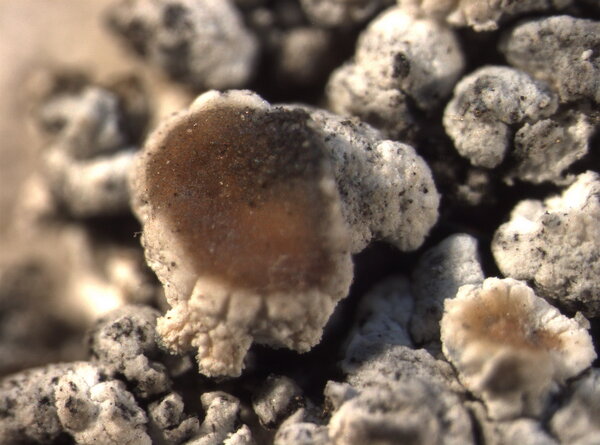Protoparmeliopsis admontensis (Zahlbr.) Hafellner
in Hafellner & al., Mitt. naturwiss. Ver. Steiermark, 134: 95, 2005. Basionym: Lecanora admontensis Zahlbr. - Ann. Mycol., 1: 357, 1903.
Synonyms: Lecanora luridescens Zahlbr.
Distribution: N - Ven (Nascimbene 2004), TAA (Nascimbene 2004, Nascimbene & al. 2004, 2004b), Lig (TSB 33615). C - Abr (Gheza & al. 2021). S - Cal (Puntillo 1996, Hafellner & al. 2005), Si.
Description: Thallus crustose-placodioid, episubstratic, chalky white or yellowish-white in the peripheral parts, thick, forming rosettes to 20 cm in diam, the central parts often dying, leaving concentric rings of lobes. Marginal lobes contiguous, 2-3 mm long, c. 0.5 mm wide, flat or slightly convex; central part of thallus areolate-verrucose. Cortex 50-70 µm thick, densely inspersed with transparent crystals soluble in HCl, and small yellow-brown granules; medulla white, filled with crystals soluble in HCl. Apothecia lecanorine, 0.5-1 mm across, usually crowded, rounded to irregular in outline, with a brown to blackish brown, usually flat disc, and an entire to crenulate thalline margin. Epithecium brownish; hymenium colourless, c. 60 µm high, inspersed with oil droplets in upper part, I+ blue; hypothecium colourless. Asci 8-spored, elongate-clavate, very thin-walled, with a K/I+ blue, tall tholus penetrated by a faintly amyloid apical cushion, the wall K/I-, surrounded by a K/I+ blue outer layer, Lecanora-type. Ascospores 1-celled, hyaline, ellipsoid, 8-12 x 5-8 µm. Photobiont chlorococcoid. Spot tests: thallus K- or K+ very pale yellow, C-, KC-, P+ yellow. Chemistry: cortex with usnic acid, medulla with psoromic acid. Note: on steeply inclined to rain-sheltered surfaces of calciferous rocks in rather dry upland areas with a rather continental climate.
Growth form: Crustose
Substrata: rocks
Photobiont: green algae other than Trentepohlia
Reproductive strategy: mainly sexual
Subcontinental: restricted to areas with a dry-subcontinental climate (e.g. dry Alpine valleys, parts of Mediterranean Italy)
In underhangs rarely wetted by rain
Commonnes-rarity: (info)
Alpine belt: extremely rare
Subalpine belt: absent
Oromediterranean belt: very rare
Montane belt: very rare
Submediterranean belt: absent
Padanian area: absent
Humid submediterranean belt: absent
Humid mediterranean belt: absent
Dry mediterranean belt: absent
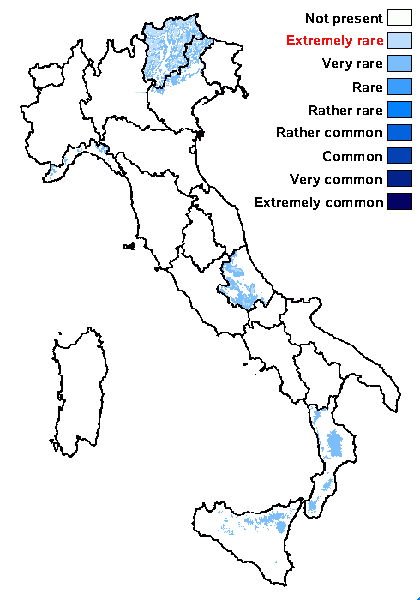
Predictive model
Herbarium samples
Growth form: Crustose
Substrata: rocks
Photobiont: green algae other than Trentepohlia
Reproductive strategy: mainly sexual
Subcontinental: restricted to areas with a dry-subcontinental climate (e.g. dry Alpine valleys, parts of Mediterranean Italy)
In underhangs rarely wetted by rain
Commonnes-rarity: (info)
Alpine belt: extremely rare
Subalpine belt: absent
Oromediterranean belt: very rare
Montane belt: very rare
Submediterranean belt: absent
Padanian area: absent
Humid submediterranean belt: absent
Humid mediterranean belt: absent
Dry mediterranean belt: absent

Predictive model
| Herbarium samples |
 Index Fungorum
Index Fungorum
 GBIF
GBIF
